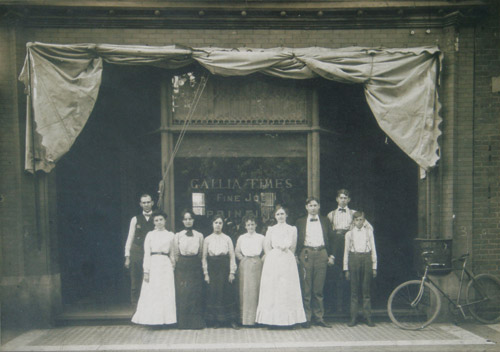 History
History
|
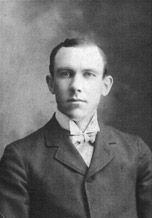 |
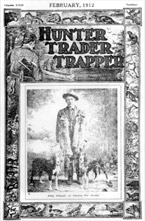 |
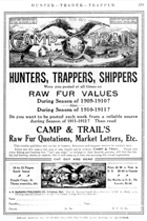 |
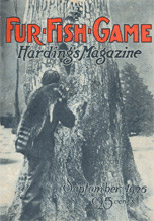 |
The eminent outdoorsmen on the American frontier considered trapping knowledge privileged information to be passed by word of mouth from friend to friend, father to son. As the land was settled more people trapped to protect their livestock and also to supplement their income by selling furs. Yet just as in the early days, trapping “secrets” were shared by a privileged few.
Arthur Robert Harding, the founder of today’s FUR-FISH-GAME, would change all of that in 1900 by publishing the first national magazine specifically for trappers and other men who earned a living in the great outdoors. The concept for the magazine arose from his own life experiences.
In 1880, at the age of nine, Harding began trapping on the family farm outside of Kyger, Ohio, close to the Ohio River. By the time he was 14, Harding was buying fur from neighboring farm boys and reselling it at a profit. About twice a month, he made his rounds on horseback. He later wrote that most of the pelts were carried in a sack, but the fox skins were tied to the saddle to “show up the horse and trader in good shape.”
By the age of 20, Mr. Harding was a salaried fur buyer, traveling by train across Ohio, West Virginia, Pennsylvania and Kentucky for L. Frank & Sons of Zanesville, Ohio.
Mr. Harding enjoyed the fur business, but he also had a keen interest in publishing. In 1898, he and a printer friend founded the Gallia Times, a weekly newspaper that served a small southern Ohio town. Using the knowledge he gained from the newspaper, he founded HUNTER-TRADER-TRAPPER magazine two years later.
The Gallia Times staff, circa 1900.
The first monthly issue went out in October 1900. Its 24 pages included articles on trapping, fur farming, the fur market, and hunting. All of the advertisers were fur dealers, most of them out of New York. The price was 5 cents, and a year’s subscription cost 50 cents. The magazine was an almost instant success, and a letter from John H. Peyton that appeared in the magazine a year later explains why:
“The Hunter-Trader-Trapper supplies the missing link to the trade. By its publication all parties interested in the trade, from the trapper and hunter to the exporter, are brought in close contact ... Its present value to the trade cannot be over estimated, its future is assured, and its publication will bring renown to the editor whose name will be known to the trade by its publication when he shall be no more.”
Mr. Harding’s foresight contributed greatly to the magazine’s success. Back in those days, few states had trapping regulations. In his editorials, Mr. Harding campaigned for fur harvest seasons and the wise use of all natural resources.
By 1904, HUNTER-TRADER-TRAPPER was growing so rapidly Harding decided to sell the Gallia Times and devote himself full time to the magazine. He moved the operations to Columbus, Ohio to gain easier access to better printing facilities. By 1906, issues of the magazine contained as many as 160 pages. This is what Mr. Harding wtote about the continuing success of his magazine:
“Letters received from raw fur dealers, trappers, and hunters lead us to believe that the H-T-T is appreciated and of value to the trapper ... One or two other papers have tried to imitate us but they died after a short existence. The cause of the short life of the other trade journals was no doubt due to the fact that the men at the head knew little or nothing of the business.
“... Our life had been spent largely in trapping and raw fur business but of course we are liable to make mistakes. If there is anything published that you think should not have been, write us, or if there is something that you would like to see discussed, write about that. The management of this journal is only too glad to hear from its friends.”
The readers responded with long letters about their their hardships as well as their successes, their dislikes as well as likes. It appears that very little editing was done before those letters saw print, and the readers loved it. Their voices were being heard all over North America.
Mr. Harding had a rather interesting method for obtaining new readers. Subscribers were offered incentives for signing up their friends, in effect turning the loyal readers into salesmen for the magazine. For example, signing up one new subscription earned a No. 81 Webbed Jaw trap, three new subscriptions was good for a bigger Newhouse trap, and 32 new subscriptions would earn a Winchester Model 1890 repeating rifle.
Mr. Harding was not content just publishing the magazine. Between 1906 and 1910, he wrote several outdoor books and purchased more titles from other authors. The A.R. Harding Publishing Co. became one of the leading outdoor book publishers of the era, and many of those same “Harding History and Pleasure Books” are being produced and sold today.
In December 1909, Mr. Harding started a weekly publication called Camp & Trail, which he described as follows:
“In general, Camp & Trail is devoted to hunting, fishing, camping, boating, prospecting, trapping and kindred subjects. One of its strong features is the Old Pioneer Department, incidents of the early days from all parts of America. The Brotherhood Gallery - pictures and sketches of Camp and Trail outdoor enthusiasts ...”
The focus of HUNTER-TRADER-TRAPPER was also broadening to include many of these same recreational activities, and in August, 1913, Camp and Trail was folded into the monthly magazine.
A year later, due to ill health, Mr. Harding sold HUNTER-TRADER-TRAPPER but retained ownership of the Pleasure and Profit Books, which he continued to publish and sell from an office in his home. For the next 10 years, he wrote articles on furs and trapping for various other outdoor and farm publications.
By 1925, Mr. Harding had regained his health and was ready to get back into the magazine business. He attempted to buy back HUNTER-TRADER-TRAPPER, but the current owners would not sell to him. So he purchased another outdoor magazine that was similar in content, changed its name from Fur News and Outdoor World to FUR-FISH-GAME, and went into direct competition with his own former magazine.
In an editorial, Mr. Harding spelled out his new magazine’s mission:
“FUR-FISH-GAME wants articles from subscribers telling of their actual experiences - whether hunting, trapping, fur buying, fishing, camping, fur farming, medicinal root growing, etc. ... The editor believes that such material is often of more interest and value than much that is written in flowing language by those who follow writing as a business. F-F-G will be of practical pleasure and profit - edited and published for those who wish to read in plain, everyday language about fur, fish, game and allied interests.”
From the beginning, FUR-FISH-GAME included monthly departments about hunting dogs, woodcraft, coon hunting, fur raising, guns, fur markets, roots and herbs, questions and answers, and fishing. Mr. Harding was one of the first national advocates of the growing field of scientific wildlife management, conservation, and good sportsmanship. He fought to keep the game laws fair and consistent. He called for shorter trapping seasons where certain furbearers were becoming scarce, and he opposed the federal government’s wide-spread use of poison to wipe out the remaining Western wolves, coyotes and other large predators.
By the late 1930s, HUNTER-TRADER-TRAPPER was out of business. But FUR-FISH-GAME continues to this day, guided by its founder’s core principles and beliefs. Arthur Robert Harding passed away in 1930, yet the fourth generation of his family is still dedicated to publishing “... a magazine edited for practical pleasure and profit - edited and published for those who wish to read in plain, everyday language about fur, fish, and game.”

